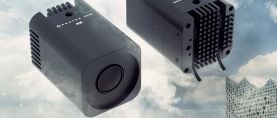
Fraunhofer Enhances EasyDCP
With more than 1,500 licensees worldwide, this solution for the creation, playback and quality control of digital cinema packages (DCP) and interoperable master format packages (IMP), is based on ISO and SMPTE standards.
The Fraunhofer IIS Department of Moving Picture Technologies, a provider of future-oriented solutions for enhanced digital-media workflows, has introduced its latest innovations for interoperable master format (IMF) workflows with the EasyDCP Software Suite. With more than 1,500 licensees worldwide, EasyDCP is a leading solution for the creation, playback and quality control of digital cinema packages (DCP) and interoperable master format packages (IMP), both based on ISO and SMPTE standards.

Among the latest additions to the software suite is a timeline-based user interface for arranging and editing input materials when composing an IMP or DCP; no separate editing tool is necessary to conform the material before importing it into EasyDCP. The software now supports markers that indicate certain events along the editing timeline. For example, inside an IMF workflow for broadcast and streaming, the editor can mark commercial blacks or credits for automated processing down the line; markers in a DCP workflow can indicate intermissions or automatically trigger a change in lighting within the theater-management system at the first frame of the end credits. High-dynamic-range and wide-color-gamut support is also included for IMF. Additionally, a new set of quality-control features have been integrated in order to ensure accuracy of input materials and encoded IMPs and DCPs. An automatically generated report contains information about image quality, as well as results of a variety of other quality-control checks that can be applied during media processing; a red or green light gives the user a quick indication on whether or not issues were detected.
The universal IMF exchange format provides flexibility in handling multiple versions of content. Little to no redundancy is created when adding dubbed or subtitled versions; this significantly reduces storage space and encoding time. Well-defined metadata in IMPs, along with transcoding rules from output profile lists, allow for the automatic creation of distribution formats — such as H.264 or QuickTime — to fit the specific device or screen. This is key for cost- and time-efficient distribution workflows.
Additionally, Fraunhofer IIS’ Lici codec is now being implemented within keyboard/video/mouse solutions. Lici offers a cost-effective transmission solution for remotely used monitors in professional image- and movie-production environments so a lower-cost wire or fiber infrastructure can be used. Also ideal for use in cameras and other multimedia applications, Lici reduces image data streams’ bandwidth while maintaining resolution and dynamic-range enhancements. The result is the visually lossless transfer of 2K, 4K and 8K content for 30 Hz and 60 Hz. Lici can be used with HDR monitors thanks to its 12-bit color-depth capability, and it can be easily implemented into new or existing systems.
For additional information, visit iis.fraunhofer.de and easydcp.com.






